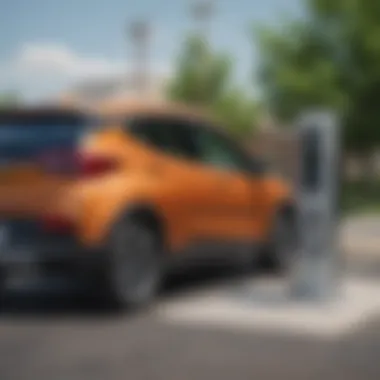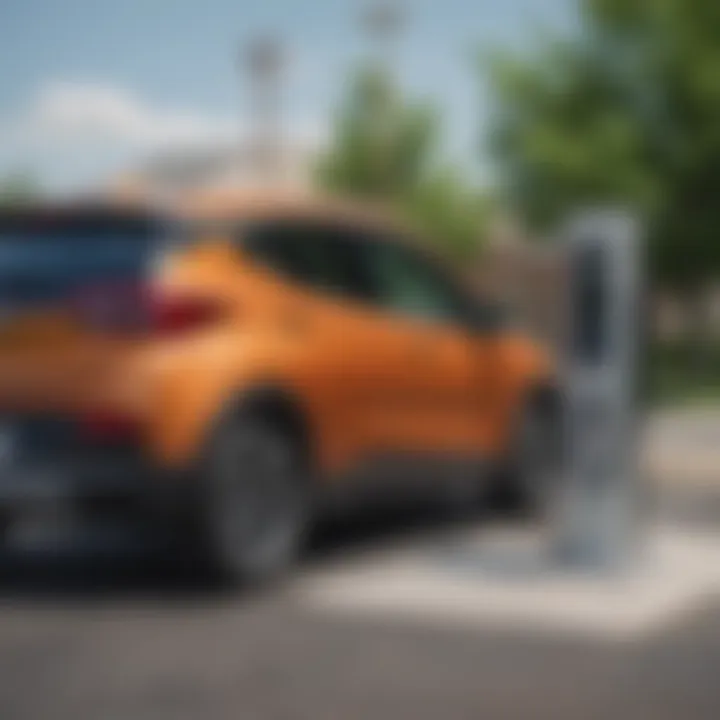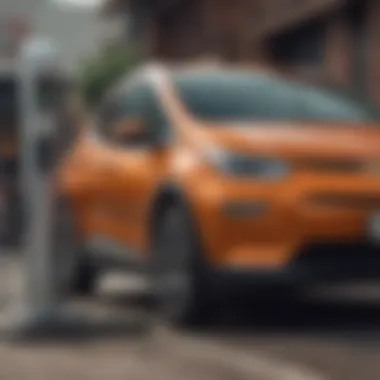Exploring Chevy Bolt Fast Charging Stations: A Comprehensive Guide


Intro
As electric vehicles become more ubiquitous, understanding the landscape of charging options is critical. This is especially true for Chevrolet Bolt owners, who benefit from a growing network of fast charging stations designed for their needs. Exploring these stations entails examining their variety, locations, technological infrastructure, and alignment with electric vehicle adoption trends across the United States. Furthermore, it is essential to examine how these stations provide practicality in terms of charging time, cost, and convenience.
Car Reviews
Overview of the Vehicle
The Chevrolet Bolt is a compact electric vehicle that marked its presence as one of America’s first affordable long-range EVs. The Bolt offers up to 259 miles of range on a single charge. With its impressive efficiency and eye-catching design, the Chevy Bolt appeals to environmentally conscious consumers and everyday drivers alike. Some features include its spacious interior and cutting-edge technology, making it a practical choice for urban commuting and long trips.
Performance Analysis
From a performance standpoint, the Bolt takes the lead among many electric vehicles within its price range. The acceleration capability from the electric motor adds a dynamic touch to its driving experience. Its responsive handling makes it suitable for city driving, while the quiet operation enhances the comfort of every journey.
In normal driving conditions, the Bolt achieves approximately 130 MPGe, illustrating an efficient energy consumption rate effectively.
Design and Interior Features
The design of the Chevrolet Bolt is modern and functional. It features a hatchback layout, allowing for generous cargo space. Optional upgrades such as heated seats and a larger touch screen elevate the interior experience. The car also includes advanced safety features, enhancing drivers' confidence on the road.
Safety Ratings and Specifications
Safety performance is a key element of the Bolt. It received commendable ratings from institutions such as the National Highway Traffic Safety Administration (NHTSA). Advanced safety options include surround-view cameras, lane-keeping assist, and automatic emergency braking, aligning with today's consumer demand for high safety standards.
Value for Money
In terms of affordability, the Chevy Bolt offers commendable value. Its initial price point is competitive when viewed alongside comparable models available today. Moreover, federal tax credits for electric vehicles often lighten the financial burden for buyers. Combined with low ownership costs due to fewer moving parts, the Chevy Bolt stands out as a smart investment for the realistic budget-minded individual.
Automotive Industry Trends
Emerging Technologies
The landscape of automotive technology is constantly evolving. Innovations in battery management and higher charging speeds are transforming how users interact with their electric vehicles. In this context, high-frequency charging technology can shave minutes off the time required to recharge the Chevy Bolt, making fast charging stations increasingly vital.
Changes in Consumer Preferences
As climate awareness grows, consumers move toward electric vehicle ownership, elevating their expectations for charging networks. Many buyers these days prioritize sustainable practices, including renewable energy sources for charging stations. This shift highlights consumer apprehensions in sustainable technologies.
Sustainability and Eco-Friendly Practices
Corporations focused on sustainability often emphasize reducing carbon footprints. Fast charging stations are becoming more integrated with renewable energy sources like solar panels. This move not only enhances costs effectiveness but also aligns with societal emphasis on conservation and preservation.
Future of Electric Vehicles
Sneaking into the future, it's clear electric vehicles will become significant surroundings on our roads. Projections indicate that more electric models will enter the automotive realm, making charging stations essential. Improved infrastructure is crucial for maintaining momentum with EV adoption.
Industry Challenges and Solutions
Despite advancements, hurdles remain. The fast-charging infrastructure must grow to keep pace with the rising number of electric vehicles. Many cities invest in expanding charging networks, mitigating installation challenges, thereby addressing the consumer concerns regarding accessibility, conveniently swaying the car buyers' decision. The urgency of this industry shift is significant; companies are exploring ways to collaborate, foster solutions utilizing technology.
“Consumers now expect reliable charge times, convenient locations, and an overall seamless experience interacting with their EV infrastructure.”
As greater electric usage scales up, customer experience becomes paramount.
Buying Guides
How to Choose the Right Vehicle
Choosing an electric model like the Chevy Bolt includes various considerations. Potential owners should evaluate their driving habits and how often they travel longer distances. Understanding power output, range, and recharging capabilities remains key components for making informed decisions.
Financing and Insurance Tips
Purchasing an electric vehicle offers unique financial dynamics. Buyers ought to explore local rebates and incentives that could influence financing options. Understanding comprehensive insurance coverage geared to electric vehicles helps pave a solid financial pathway.
Common Mistakes to Avoid
Prospective electric vehicle owners often misconstrue charging time. Anticipating required infrastructure at home or familiar public systems can relieve misunderstandings and enhance overall satisfaction. Additionally, overlooking government incentives might diminish financial leverage potential.
Maintenance and Ownership Considerations
Owning a Chevrolet Bolt generally asserts lower physical maintenance requirements. Nonetheless, regular handling recommends addressing software updates and battery monitoring. Being aware of charging habits greatly influences prolonging battery lifespan, essential to the overall ownership experience.
Resources for Further Research
Stay updated through world-renowned sources such as Wikipedia and Britannica for thorough insights. Joining online forums like Reddit presents another method to engage with alliance groups focusing on electric vehicle discussions. The accessibility of relevant knowledge empowers ownership and enhances comprehension about charging infrastructure and future trends.
Preface to Chevy Bolt Fast Charging
Fast charging for electric vehicles represents a critical component in the sustainable mobility landscape. As more consumers consider adopting electric vehicles, understanding the perks and conditions related to Chevy Bolt fast charging is increasingly important. This discussion illustrates how fast charging not only accelerates the charging process but also increases EV accessibility.


Understanding Electric Vehicle Charging
Electric vehicle charging is categorized into several types. Primarily, there are three levels: Level 1, Level 2, and DC fast charging. Each level varies in voltage and current capacity, influencing charge time and operational efficiency. For instance, Level 1 uses a standard household outlet and is slower, while DC fast charging can restore substantial battery range in a mere thirty minutes.
Fast charging stations provide properties crucial for a seamless driver experience, particularly for Chevy Bolt owners. They enable routine long-distance travels without extensive downtimes, addressing drivers' continual concerns about range anxiety.
Key considerations about electric vehicle charging include:
- Charging speed versus battery health: Frequent fast charging can potentially affect long-term battery performance.
- Location diversity: Convenience of charging station locations determines user experience significantly.
- Infrastructure support: A growing fast charging network fosters EV adoption and alleviates concerns surrounding limited range.
Overview of the Chevy Bolt
Chevrolet’s Bolt EV is a prominent choice in the electric vehicle market, standing out for its affordable price, substantial range capability, and overall efficiency. With a range exceeding 250 miles on a single charge, it hits the sweet spot of usability for most drivers.
The Chevy Bolt employs innovative technology, granting vital networking features through mobile connections, enhancing user convenience in managing charging stations.
As electric vehicles trend upwards, owning a Bolt becomes strategically advantageous, aligning well with a commitment toward sustainable energy and transport practices. Additional valuable attributes include:
- Roomy interior space and cargo opportunities.
- User-friendly interface with cutting-edge tech features.
Moreover, the Bolt’s compatibility with fast charging stations directly supports the broader transition toward electric mobility, emphasizing its role in a sustainable future.
“Understanding fast charging infrastructure can empower Chevy Bolt owners to make informed decisions toward electric future.”
Types of Fast Charging Stations
Understanding the different types of fast charging stations is essential for Chevy Bolt owners. Each type offers specific features and advantages suitable for diverse driving and charging habits. This knowledge helps in deciding which charging solution fits individual needs, whether on road trips, daily commutes, or overnight charging.
Level Charging Stations
Level 2 charging stations are common in residential, commercial, and public locations. These stations operate at 240 volts and provide a charging speed of about 10 to 20 miles of range per hour. They are ideal for situations where a vehicle can be parked for a longer time, such as at workplaces or shopping centers.
Notable points about Level 2 stations include:
- Installation Flexibility: Many properties can have Level 2 charging installed relatively easy.
- Cost-Effective: The equipment itself can be less expensive compared to DC fast chargers.
- Availability: Numerous businesses offer Level 2 stations to attract electric vehicle drivers.
However, they require longer charging times compared to faster alternatives. Understanding ideal scenarios for their usage is critical.
Fast Charging Stations
DC fast charging stations provide quicker charging solutions. These stations use direct current to charge vehicle batteries rapidly, enabling users to gain around 60 to 100 miles of range in about 30 minutes. This makes them favorable for long trips and out-of-town driving.
Key characteristics of DC fast charging stations include:
- Speed: The most considerable advantage is the significantly decreased time spend recharging.
- Locations: Commonly found along highways or urban centers to support road trips.
- Compatibility: Often used for networks like DCFC and CCS, suitable to Chevy Bolt.
While the charging time is drastically improved, access can vary. It is prudent to plan ahead, especially for routes with limited DC fast chargers available.
Home Charging Solutions
Having a home charging solution provides convenience for Chevy Bolt owners. Often, professional installation of a Level 2 charger can convert home garages into efficient charging stations. This allows drivers to start and end their day with a fully charged vehicle.
Considerations for home charging solutions:
- Cost of Installation: Initial investment in equipment and installation must be weighed, though over time it can save operational costs.
- Convenience: Comfort of charging overnight means drivers set the vehicle to be available when needed.
- Electricity Rates: Understanding local electricity rates can lead to substantial savings, especially if charging during off-peak hours.
Location of Fast Charging Stations
Understanding the location of fast charging stations is crucial as it directly influences the feasibility and convenience of owning a Chevrolet Bolt. While the Chevy Bolt provides remarkable electric range, the ability to access fast charging can alleviate range anxiety and enhance the overall ownership experience. This segment covers the primary networks, mapping options for users, and considers public accessibility—effective strategies that would increase model adoption.
Major Fast Charging Networks
Key players have emerged in the fast-charging network arena. Networks such as ChargePoint, Electrify America, and EVgo are at the forefront, providing reliable options for Chevy Bolt owners. These networks operate broadly across the United States, allowing easy access for users.
Each of these networks brings unique features to the table:
- ChargePoint is notable for maintaining the largest network, with chargers available across densely populated regions and highways.
- Electrify America emphasizes speed and has high-power DC chargers, making fast charging accessible for long-distance travel.
- EVgo excels in urban settings, providing convenient charging in areas where daily commuters frequent.
Working of these networks is generally seamless for users. Collaborative efforts among them make it easier to squat at charging locations throughout various metropolitan regions.
Mapping Fast Charging Stations
Locating fast charging stations can be daunting without proper tools. Several mobile apps and websites provide mapping services that ease this process. Many owners of the Chevy Bolt rely on tools like the PlugShare app and A Better Routeplanner to discover their nearest charging option. These mapping solutions involve interactive features like:
- Real-time availability of charging stations.
- User-rated experiences about charging ease and accessibility.
- Integrated payment options for faster transactions at the station.
These applications increase user confidence, allowing users to plan their routes without fear of running out of charge. As the demand for electric vehicles continues to grow, improved maps integrating geographic and user-generated data will shed light on stations identified as significant for whole communities.
Public Accessibility and Availability
Public accessibility to fast charging stations varies greatly depending on one’s region. In urban settings, stations are generally abundant. Comparatively, rural areas may lack sufficient coverage, limiting options for charging. As charging infrastructure matures, initiatives are undertaken to remedy this imbalance. Noteworthy considerations regarding public accessibility and availability include:


- Federal and state initiatives are constantly pushing for more stations, equipping highways and parks.
- Various government agencies are beginning to approve charging locations that address the needs of those who lower typically have access to EV infrastructure.
- Community charging programs and partnerships promoted local installations with government incentives for easy public accessibility.
While challenges exist, the strategy to provide robust public access is accelerating gradually as necessity meets opportunity in this evolving market. The relevance of this issue cannot be overstated when evaluating the landscape for electric vehicle use moving forward.
The evolution of fast charging infrastructure is not merely confined geographically but also tactically aligns discussions about energy needs and urban planning for future considerations.
Technology Behind Fast Charging
The realm of fast charging stands as a cornerstone in the electric vehicle landscape, given its role in enhancing the convenience and efficiency of owning an electric car, particularly the Chevrolet Bolt. Understanding the technology behind fast charging is crucial for bolting into the practical modern implications of EVs. Factors such as charging standards, performance of battery management, and the connectivity of infrastructure converge to create a seamless experience for drivers. A well-integrated ecosystem ensures users have the easy access to powerful charging solutions that's crucial for adapting to electric transportation.
Charging Standards Explained
Charge standards dictate the rapidity with which a vehicle can replenish its energy store. In the fast charging context, various standards play distinctive roles. The two primary ones encompass CHAdeMO and CCS (Combined Charging System).
- CHAdeMO: Originating from Japan, this standard allows for rapid DC charging. It supports fast refueling for compatible vehicles when plugged into their charging stations.
- CCS: The European-developed Combined Charging System supports both AC and DC charging. Its versatility lends itself to being the predominant standard in North America, especially for the Chevy Bolt.
Understanding these standards is fundamental. It informs owners what stations to jointly track and supports the compatibility of their vehicles with existing charging infrastructure. Effectively, employing these standards helps maximize charging networks.
Battery Management Systems
Battery Management Systems (BMS) serve as the brain behind the charging process. A responsive BMS contributes invaluable safety and longevity of the lithium-ion batteries found in most electric vehicles including the Chevy Bolt.
A few key functions of battery management systems include:
- ** Voltage Regulation**: Ensures the cells are operating within safe limits, preventing voltage spikes.
- State of Charge Monitoring: Accurately assesses the battery's charge level and health status, notifying users when care is needed.
- Thermal Management: Acts excellent in regulating the temperature of the battery pack, maintaining optimal performance during both charging and discharging cycles.
Adopting improved BMS technologies allows the Chevy Bolt to achieve faster charging times while safeguarding the battery life.
Charging Time and Efficiency
Charging time and efficiency are critical factors for Chevy Bolt owners when considering fast charging options. These factors not only affect how quickly drivers can hit the road but also impact the overall convenience of electric vehicle ownership. The ability to charge efficiently saves time, reduces anxiety of range, and increases the practicality of using electric cars in daily life.
Understanding Charge Times
Charge times describe how long it takes to replenish an electric vehicle's battery from an empty or low level. For the Chevy Bolt specifically, charging can vary significantly based on the stations and technology used.
Level Charging Stations
These stations typically provide a charge time ranging from 4 to 8 hours for a full battery. While longer than DC fast charging, Level 2 stations are commonly found in residential garages or workplaces, allowing for slower charging that aligns well with overnight or workday schedules.
Fast Charging Stations
On the other hand, DC fast charging drastically reduces charge times down to approximately 30 minutes to achieve 80% battery capacity. This significant efficiency can be especially valuable during long trips, allowing quick stops to recharge without lengthy wait times.
Studies show that the time saved in DC charging compared to slower options leads to more efficient route planning and reduces excess trips to charging stations.
Charge Times and Route Planning
Understanding charge times will help gear route planning around refueling stops. Owners should consider locating fast charging stations along cross-country trips or urban areas, maximizing the convenience afforded by faster recharge capabilities.
Factors Affecting Charging Speed
Several elements influence the speed at which an electric car battery charges. The following details help clarify CP relative speeds when charging at different facilities.
- Power Output Limitation: Each fast charging station has a maximum power output. The more powerful the station, the quicker the charge. Faster charging is offered by installations like ChargePoint and Electrify America, which commonly offer upwards of 150 kW power.
- Battery Congestion Management: Battery systems have built-in mechanisms while charging to protect against overheating and other damage. This limitation can slow charging speed after a battery reaches a certain state of charge.
- Environmental Factors: External temperature can also affect charging speed. Colder conditions tend to slow down battery chemical reactions, making charge times longer compared to warmer scenarios.
- Battery Technology: Different charges schemes Volume control different chemistrys which are able to be charged efficiently. Newer vehicles, for example, adapt certain chemistrys for fast charging compared to previous models.
Being aware of these factors enables Chevy Bolt owners to make informed decisions about charging locations and timing. This knowledge can maximize efficiency as strategies converge on optimizing routes combined with technology available at specific charging stations.
Cost Considerations
Analyzing the cost considerations surrounding fast charging stations for the Chevy Bolt is essential for both current and prospective electric vehicle owners. Understanding these key financial aspects can help users make informed decisions when selecting a charging solution that best fits their individual needs. The costs associated with charging stations can vary widely based on factors including the charging model, location, and access to incentives.
Pricing Models of Charging Stations
When evaluating charging stations, different pricing models can be observed. These models typically fall into two main categories: pay-per-use and subscription-based services. Each model has pros and cons that need consideration.
- Pay-per-use pricing: Users pay a set fee for each charging session. This model is common among public charging stations, which may charge consumers based on the duration of usage or the amount of electricity dispensed. For example, networks such as EVgo and ChargePoint often use this system.
- Subscription plans: Some networks offer flat monthly fees that allow users unlimited access to charging. This option may benefit those who frequently utilize charging stations, as consistent users can save money over time through a subscription, rather than incurring separate charges per session.
Moreover, it's crucial for owners to be aware of potential hidden fees such as idle fees. These fees may apply if a vehicle remains connected to a fast charger after it has finished charging. Knowing the cost structure can improve budgeting for car owners and inform their charging habits accordingly.
Incentives and Rebates for EV Charging
Various incentives exist to ease the financial burden associated with EV charging. Both federal and state governments offer programs aimed at encouraging the adoption of electric vehicles.
Several initiatives worth noting include:
- Federal Tax Credits: In the United States, owners of electric vehicles may benefit from a federal tax credit upon purchase. Currently, this incentive can offer considerable savings based on the model and battery capacity of the Boise Bolt.
- State Incentives: Many states provide rebates or tax incentives specifically for homeowners installing charging stations. This can offset the costs associated with setting up home charging solutions.
- Utility Programs: Several local utilities offer rebates related to increased load due to electric vehicle charging, incentivizing homeowners to install suitable stations.
These financial incentives represent valuable opportunities for existing and potential Chevy Bolt owners. The intersect of lower upfront costs and long-term savings from charging can encourage widespread electric vehicle adoption and contribute to more affordability in the market overall.
Access to the financial incentives often hinges on local regulations and program availability. Owners should stay informed of new initiatives that may arise in the future to maximize potential savings.


By deciphering all cost and pricing information effectively, Chevy Bolt owners can mitigate their expenses and tailor their charging behavior in alignment with their energy consumption.
User Experience and Convenience
User experience and convenience are critical factors for users of fast charging stations, particularly for Chevrolet Bolt owners. The ease with which they can access and utilize charging infrastructure has a direct impact on their overall satisfaction and the practicality of owning an electric vehicle. Evaluating user experience involves analyzing several aspects of the charging stations, including accessibility, the usability of the interfaces, and the efficiency of the charging process. Convenience plays a substantial role, as it impacts the frequency at which users adopt fast charging solutions. In a world where time is valuable, motorists must find fast charging stations to be straightforward and uncomplicated.
Ease of Use for Bolt Owners
For Chevrolet Bolt owners, the ease of use at charging stations cannot be overstated. Several elements contribute to an effectively user-friendly experience. Firstly, the physical layout of stations is important. Well-marked, recognizable charging stations ensure quick identification in public spaces. Ideally, stations should have multiple charging ports to minimize wait times. Further, styling and dimensions of charging equipment should expressly cater to Bolt owners without compromising other vehicles that may also utilize these facilities.
Standardized chargers across stations help eliminate confusion and compatibility issues. Aligning the charging cables correctly and understanding the signaling from the machine simplify the overall interaction. A reliable and intuitive process increases user confidence, promoting frequent use of charging stations.
Mobile Apps for Charging Station Locators
Mobile apps play an instrumental role in enhancing the charging experience for Chevy Bolt drivers. These applications offer numerous functionalities that benefit users who need to locate available charging spaces efficiently. Common features in these apps include real-time status updates on charger availability and user review systems. Such insights significantly benefit riders when seeking stations on their journey.
Popular applications like PlugShare, ChargePoint app, and EVgo simplify planning for road trips or commuting. Users can input their starting point and destination, allowing apps to generate routes featuring available charging locations and their specifications. Additionally, it streamlines the entire charging experience with navigation assistance.
“User-friendly technology leads to better satisfaction and increased adoption of fast charging as a crucial infrastructure for electric vehicles.”
Users gain unnecessary stress of finding location without explicit directions. The ability to filter by charging speed, type of connector, and station services helps in deciding which station meets their needs best. As goals for widespread adoption of electric vehicles grow, providing effective tools through mobile applications remains crucial for successful implementation.
Case Studies: Successful Fast Charging Installations
The implementation of fast charging stations has been crucial as more people adopt electric vehicles, particularly the Chevrolet Bolt. This section highlights prominent case studies of successful fast charging installations, emphasizing their implications and benefits for Chevy Bolt owners.
Urban Charging Station Networks
Urban environments present unique challenges and opportunities for fast charging solutions. Major cities have increasingly recognized the need for structured charging infrastructure to meet the demands of electric vehicle users. Case studies show that urban charging station networks not only enhance accessibility but also contribute to the proliferation of EV usage.
For example, cities like Los Angeles and New York have deployed extensive networks of DC Fast Charging stations throughout regions where residents heavily rely on personal electric transport. These installations are typically located at strategic points, such as shopping centers, parking structures, and other high-traffic areas. This geographic strategy builds a strong confidence among users because knowing that fast charging stations are available reduces range anxiety.
Charging stations within urban settings also allow users to expedite their charging while taking care of daily activities. Many users appreciate the capability to charge their vehicles while engaging in errands. Urban charging infrastructure is, therefore, more than an attraction for EV users; it becomes integrated within the city’s day-to-day life.
Fleet Charging Solutions
Electric vehicle infrastructure must also analyze the needs of commercial fleets. Organizations, such as Uber and delivery services, are starting to transition to all-electric fleets for many of their operations. Fast charging stations tailored to fleet requirements represent significant advantages in terms of managing time and costs.
Hotels that incorporate bulk charging solutions can serve fleet partnerships, optimally scheduling charging times to ensure cars are ready for use around the clock. Furthermore, fleet charges using fast stations reduce downtime. By installing fast charging stations, companies can maintain battery performance and regular vehicle upkeep efficiently. The success of these fleet charging solutions evolves by focusing on focused installation in commercial premises where the cumulative benefits for time management and productivity become evident.
Establishing fast charging stations dedicated exclusively to service fleets leads to optimized vehicle operating costs, reduced emissions in terms of maintenance, and ultimately supports sustainable growth within urban envelopes.
In summary, the case studies in both urban networks and fleet solutions underline the capability of fast charging installations in reshaping the electric vehicle landscape. The insights gained from these practical Chris's, provide essential guidance necessary as Ford adopts electric mobility heavily.
Challenges Facing Fast Charging Infrastructure
Fast charging infrastructure plays a crucial role in the widespread adoption of electric vehicles, especially for models like the Chevrolet Bolt. However, it is not without its various challenges. Addressing these obstacles is essential for optimizing user experience and increasing integration into the existing road and energy networks. The importance of understanding these challenges cannot be overstated, as they impact everything from charging time to user convenience.
Technical Challenges
One primary technical challenge with fast charging is the creation of standardization across different manufacturers. Currently, charging stations often vary in terms of connector types and charging speeds. The Chevy Bolt uses specific connectors which may not be universally available, leading to inefficiencies. The compatibility issue impacts user confidence. If a Bolts owner is unsure whether a charging station will work with their vehicle, they may avoid long-distance travel, which deters broader adoption of EVs.
Additionally, infrastructure installation often encounters issues related to grid capacity. Not all areas can support multiple fast charging stations without potential outages. Upgrading the local electrical grid increases cost and complexity for both operators and investment for city planners. Furthermore, battery technology is advancing, meaning fast charging stations must regularly upgrade their capacities to accommodate newer vehicles.
When charging speed increases, heat is generated. Managing heat effectively remains a complicated process. Overheating can damage both the charging equipment and the vehicle's battery. Systems should be designed for both fast and safe charging
Regulatory Hurdles
Regulatory hurdles represent another significant challenge for the fast charging infrastructure. Governments often need to catch up with rapid advancements in electric vehicle technology. Right now, there are no uniform regulations across different states, making compliance more difficult for business owners.
Most regulatory frameworks regarding charging stations are still in early stages. Issues such as property rights and service area demands complicate planning approvals. Operators face criticism over the perceived accessibility of fast chargers. Some claim a lack of being on key routes undermines the potential benefits these infrastructures can provide for longer trips.
Permits are essential. navigateing local, state, and federal environmental guidelines is a time-consuming task. It delays the construction of new fast charging stations. Simplifying this process can help rapidly deploy these essential infrastructures.
Even existing rules and safety standards relating to electrical work can often be outdated for newer fast charging protocols. This gap must be addressed to allow charges to become more seamlessly integrated into everyday travel.
Understanding both the technical and regulatory challenges can highlight pathways towards improving fast charging stations. Bridging these gaps can enhance accessibility for all Chevy Bolt users.
The Future of Fast Charging for the Chevy Bolt
The trajectory of fast charging for the Chevy Bolt is crucial in understanding how electric vehicles will be adopted more widely. First, it addresses increasing anxieties surrounding charging accessibility and time, which are often the primary barriers for prospective electric vehicle owners. As advancements occur in charging technology, they can lead to improved efficiency and reduced costs, making ownership of a Bolt more appealing. Fast charging stations are the veins of the electric vehicle ecosystem, directly influencing user experience and satisfaction.
Predictions for Charging Technology Advances
The realm of charging technology is evolving at an impressive rate. Experts predict a few key advancements that will redefine how Chevy Bolt owners will charge their vehicles in the near future.
- Ultra-Fast Charging Capabilities: Emerging technologies promise charging times of under 15 minutes for a significant range. Solid-state batteries look increasingly capable of supporting this rapid deployment.
- Smart Charging Networks: Integrating smart technology into charging infrastructure can optimize energy expenditure. Smart chargers can communicate with the electric grid, ensuring that OG producers supply power at optimal times.
- Wireless Charging Solutions: As inductive charging technology matures, it holds promise in enabling Bolt owners to charge without physical connections, potentially transforming parking lot layouts.
- Increased Standardization: With organizations working toward universal charging standards, this might help unify the fragmented infrastructure across different platforms.
- Battery Lifetime Improvement: New developments in battery chemistry may increase the longevity of batteries without reducing their charge capacity.
These advances can enhance the functionality of fast charging for the Chevy Bolt, addressing issues that currently concern users.
Emerging Trends in EV Infrastructure
New trends in electric vehicle infrastructure reflect the growing awareness of the importance of charging systems. The insights from these trends might reshape the landscape in which the Chevy Bolt excels.
- Public Charging Investments: More government incentives are emerging, aiming to create an expansive network that encourages more fast charging stations in urban and rural regions, leading to increased accessibility for all.
- Multi-Modal Charging Stations: Stations, combining electric and hydrogen fueling options, may become prevalent, allowing adaptability to various vehicle types and charging preferences.
- Fleet Charging Solutions: Commercial interest in electric fleets leads to focused development of charging facilities tailored for businesses, which can parallel the infrastructure for personal vehicles like the Bolt.
- Regional Collaboration: Inter-city partnerships can lead to charging station networks across neighboring territories with an emphasis on location-sharing and resource optimization.
These trends signify not just the growth of charging infrastructure but also a Maljor shift in how communities perceive and engage with electric vehicle solutions.







